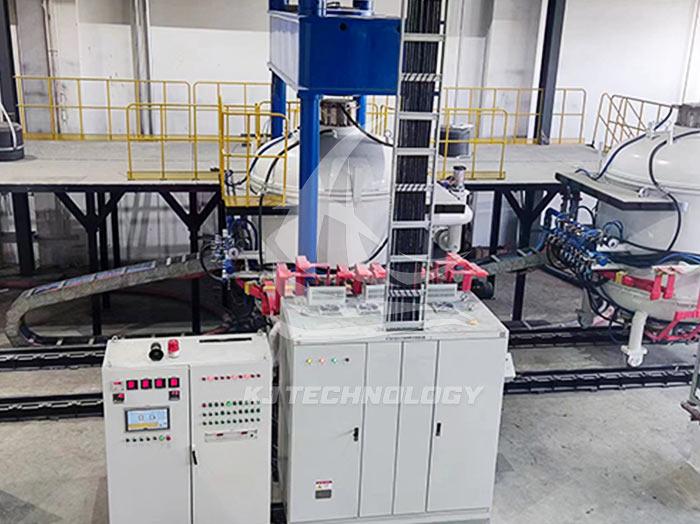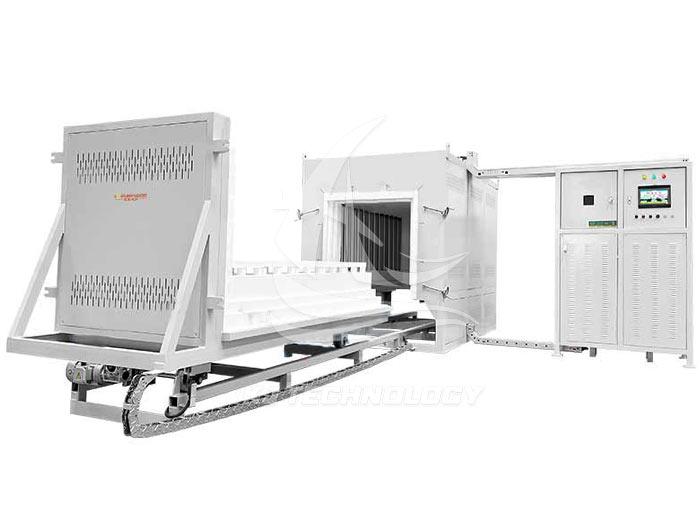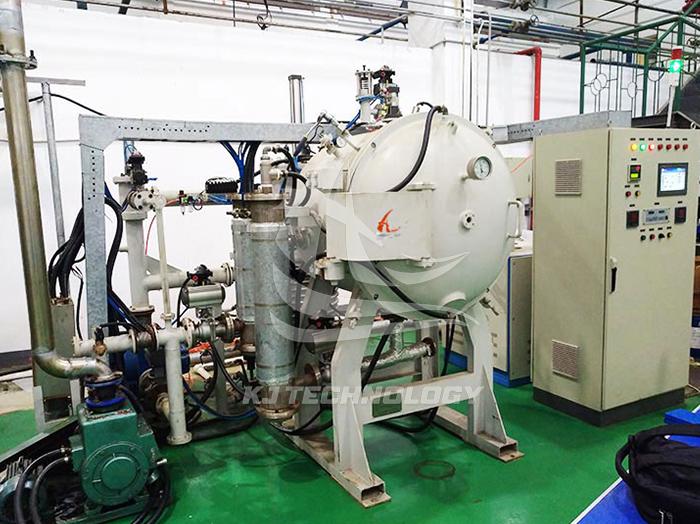Application fields of vacuum hot pressing furnace
 07-07-2025 Author: KJ technology
07-07-2025 Author: KJ technology
As a precision equipment that combines vacuum environment, high-temperature heating, and mechanical pressurization, the vacuum hot press furnace has a wide range of applications and high technical requirements, mainly covering cutting-edge fields such as materials science, advanced manufacturing, and new energy. The following is a detailed analysis of its core application areas:
1. Hard alloy and metal material processing
Manufacturing of Hard Alloy Cutting Tools
Application scenario: After mixing tungsten powder, cobalt powder and other metal powders into a compact, they are hot pressed and sintered at 1400-1450 ℃ and 20-30 MPa pressure to produce tool materials with high hardness (HRA ≥ 92) and high wear resistance.
Technical advantages: Vacuum environment prevents oxidation, pressure promotes metallurgical bonding between particles, product density reaches over 99.5%, and service life is increased by 30% -50% compared to traditional processes.
Preparation of metal based composite materials
Typical materials: Aluminum based, titanium based composite materials (such as carbon fiber reinforced aluminum based composite materials).
Process features: Achieve uniform composite of metal and reinforcing phases (such as carbon fiber and ceramic particles) under high temperature and high pressure. The product has both high strength (tensile strength ≥ 800 MPa) and lightweight (density ≤ 3.0 g/cm ³) characteristics, and is widely used in aerospace structural components.
2. Preparation of Advanced Ceramic Materials
Structural ceramics
Application cases: Silicon nitride (Si ∝ N ₄), silicon carbide (SiC) ceramic bearing balls, valve seals.
Technological advantages:
Vacuum hot pressing sintering can eliminate internal pores in ceramics, achieving a density of 99.8% and a bending strength of ≥ 800 MPa;
Pressure promotes grain refinement, improves material toughness, and solves the problem of high brittleness in traditional ceramics.
Functional ceramics
Typical products: piezoelectric ceramics (such as PZT), transparent ceramics (such as YAG laser crystals).
Technological breakthrough:
Piezoelectric ceramics are formed under high voltage, resulting in a 20% improvement in electrical performance uniformity;
Transparent ceramics achieve a transmittance of ≥ 85% through vacuum hot pressing, and are used in high-end fields such as laser windows and transparent armor.
3. Powder metallurgy and special materials
Powder Metallurgical Parts
Application scope: high-precision parts such as automotive gears, connecting rods, molds, etc.
Technological advantages:
Near net forming technology reduces subsequent processing volume and increases material utilization by 40%;
Pressure promotes diffusion and bonding between powder particles, resulting in a product density close to theoretical values and mechanical properties superior to traditional forged parts.
Nanomaterials and composite powders
Technical difficulties: nano powder is easy to agglomerate, and the grain is easy to coarsen during sintering.
Solution:
The vacuum hot pressing sintering temperature is 200-400 ℃ lower than atmospheric pressure, effectively suppressing grain growth;
Pressure promotes the thermoplastic flow of powder, achieving a fine grain structure (grain size ≤ 100 nm), and improving material strength and toughness.
4. New energy and semiconductor fields
Lithium Ion Battery Materials
Application scenarios: Positive electrode materials (such as LiCoO ₂ NCM)、 Sintering of negative electrode materials (such as silicon carbon composite materials).
Process requirements:
Vacuum environment prevents material oxidation and ensures stable electrochemical performance;
Pressure promotes inter particle contact, improves material conductivity and cycle life (≥ 1000 times).
Semiconductor packaging materials
Typical materials: ceramic packaging substrates (such as AlN, Al ₂ O ∝), metal based composite packaging materials.
Technical advantages:
Vacuum hot pressing achieves matching of thermal expansion coefficients between materials and chips, reducing failures caused by thermal stress;
High density (≥ 99%) ensures airtightness and meets the high requirements of semiconductor devices for packaging environment.
5. Aerospace and Defense Industry
High temperature alloy components
Application case: High temperature resistant components such as turbine blades and combustion chamber liners.
Process characteristics:
Hot pressing at 1600-1800 ℃ and 50-100 MPa pressure results in fine and uniform grain size of the material;
The vacuum environment prevents oxidation, significantly improving the high-temperature strength (≥ 1000 MPa) and creep resistance of the product.
Carbon fiber reinforced composites
Typical products: Lightweight structural components such as aircraft wings and missile shells.
Technological breakthrough:
The vacuum hot pressing curing process eliminates internal pores in the material and increases interlayer shear strength by 30%;
The specific strength (strength/density) of the product is 5-10 times that of steel, meeting the demand for weight reduction in aerospace.
6. Biomedical and Special Functional Materials
Bioceramic implants
Application scenarios: artificial joints, dental implants, etc.
Process requirements:
Vacuum hot pressing sintering achieves high densification of biologically inert ceramics (such as ZrO ₂, Al ₂ O3) and reduces bacterial adhesion;
Pressure promotes the diffusion bonding between ceramics and metals (such as titanium alloys), improving the bonding strength between implants and bone tissue.
magnetic material
Typical products: NdFeB permanent magnets and soft magnetic alloys.
Technical advantages:
Vacuum hot pressing suppresses the oxidation of magnetic particles, increasing remanence (Br) and coercivity (Hc) by 15% -20%;
Pressure promotes consistent magnetic domain orientation, with a maximum magnetic energy product (BH) of over 50 MGOe, widely used in fields such as motors and wind power.
7. Research and development of new materials
Exploration of New Materials
Research areas: metallic glass, high entropy alloys, two-dimensional materials (such as graphene reinforced composites), etc.
Equipment value:
The vacuum hot press furnace provides a controllable temperature and pressure field environment, supporting the transformation of new materials from the laboratory to industrialization;
For example, by adjusting pressure and temperature parameters, new composite materials with superhard, self-lubricating and other characteristics can be prepared.
Material performance optimization
Application case: Improving the fracture toughness of ceramics and the fatigue life of metals through hot pressing technology.
Technical path: Combining computer simulation, optimizing temperature pressure curve, and achieving precise control of material microstructure.








